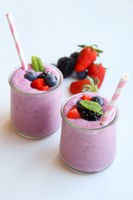Prairie Fare: Eat More Fruit With These 6 Tips
(Click an image below to view a high-resolution image that can be downloaded)
By Julie Garden-Robinson, Food and Nutrition Specialist
NDSU Extension
“Mom, how much fruit is too much?” my older daughter asked. “I have been eating a lot of fruit.”
I probably raised my eyebrows when I read her text message.
I did not think my kids would ever be concerned about eating too much fruits -- or vegetables, either.
“Do you have a stomachache?” I asked.
“No. I am just eating a lot of fruit since you gave me a blender,” she said.
I was happy to hear that her Christmas gift had the desired outcome: eating more fruits.
She had purchased frozen fruit and was exploring smoothie recipes in her kitchen.
I was inspired by her comment. I need to put my blender to use this winter.
Fruits are a notable source of vitamin C, potassium, folate, fiber and natural antioxidants. This combination of nutrients may strengthen our immune systems, assist with digestion and provide hydration.
When we eat plenty of fruits and vegetables, we are helping our bodies fight chronic diseases. Eating enough fruits and vegetables can help with blood pressure management and reduce our risk for cancer, heart disease, diabetes and strokes.
We tend to feel less hungry when we eat fiber-rich foods. That can help with maintaining our weight.
How much fruit do we need? The recommendation for fruit varies a bit from person to person. If we are physically active, we usually need more food.
As a general rule, women ages 19 and older need 1 1/2 to 2 cups of fruit daily, while men ages 19 to 59 need 2 to 2 1/2 cups daily. Men ages 60 and older need 2 cups per day.
See www.myplate.gov/myplate-plan to see the recommended amount of food from the five food groups personalized for your age and activity level.
The thought of eating 1 1/2 to 2 cups of fruit daily may seem to be a lot or maybe, a little, depending on your preferences. You may be meeting the goal already.
Consider tracking your fruit intake for a few days and see how you are doing.
You may want to do the same “tracking” with vegetables. People tend to shortchange themselves on vegetables, and we usually need more vegetables than fruits in our diet.
Remember that variety is key in our diet. Enjoy a variety of fruits.
For instance, bananas are an excellent source of potassium, but they are not particularly high in vitamin C. Citrus fruits are notable sources of vitamin C.
A “cup” of fruit varies a bit depending on the fruit. For example, 22 seedless grapes counts as a cup because that is about the number of grapes that fit in a measuring cup. A medium grapefruit counts as a cup. Half a large apple, a large banana, peach or orange each counts as a “cup” of fruit.
You can count a cup of 100% fruit juice as one cup. Aim for more whole fruits in your diet than juice for the fiber advantage.
Fresh, canned, dried and frozen fruit all “count” toward the goal. Save money by exploring different forms of fruit depending on the season. Be a little adventuresome with food choices; try a fruit you have never tried next time you shop the various aisles in a grocery store.
Here are some tips to help you meet your fruit consumption goal.
- Include fruit as part of your breakfast. Consider slicing a banana on your cereal or adding some dried cranberries or raisins to your oatmeal. Add some chopped apples or mashed bananas to muffin mix.
- Take fruit with you as a snack. Check out the juice-packed individual portions of fruit for a quick pick-me-up.
- Make trail mix. Try adding some dried fruit, such as pineapple or apricots, to cereal and nuts. Prepackage in plastic zip-top bags.
- Keep fruit in view. Rinse apples and have them available on your counter top ready to grab for a snack. Place prepared fruit in clear containers in your refrigerator.
- Consider having fruit for dessert. Make an upside down ice cream sundae with fruit on the bottom topped with ice cream or frozen yogurt.
- Try fruit kabobs on the grill or served fresh.
Smoothies are tasty and refreshing in the winter. A fruit smoothie made with yogurt, milk and fruit is a portable breakfast. You also can toss in a handful of spinach to get more vegetables in your diet.
This smoothie is packed with nutrition. Berries of all types are excellent sources of vitamin C and natural antioxidants that have disease-fighting properties. Milk and yogurt are excellent sources of calcium, vitamin D, protein and several other nutrients.
Berry-Yogurt Smoothie
1 cup low-fat vanilla Greek yogurt
2 cups frozen raspberries or blueberries, unsweetened
1 cup frozen strawberries, unsweetened
3/4 cup fat-free or low-fat milk
1cup ice (about 12 cubes)
Blend all ingredients in a blender or food processor until smooth. Serve immediately.
Makes four servings. Each serving has 120 calories, 2 grams (g) fat, 8 g protein, 20 g carbohydrate, 5 g fiber and 45 milligrams sodium.
(Julie Garden-Robinson, Ph.D., R.D., L.R.D., is a North Dakota State University Extension food and nutrition specialist and professor in the Department of Health, Nutrition and Exercise Sciences. Follow her on Twitter @jgardenrobinson)
NDSU Agriculture Communication – Feb. 3, 2022
Source: Julie Garden-Robinson, 701-231-7187, julie.garden-robinson@ndsu.edu
Editor: Elizabeth Cronin, 701-231-5391, elizabeth.cronin@ndsu.edu




